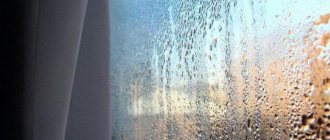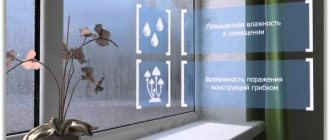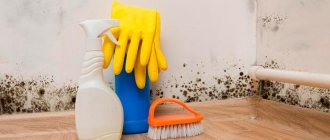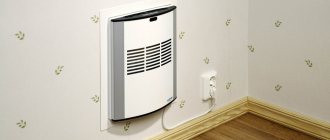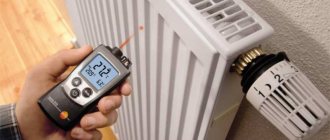How to measure humidity level?
Maybe it just seemed to you that the air in the apartment is normal? Does your skin dry out due to improper care? To find out for sure, you need to measure the humidity level in the room. This is not difficult to do, there are even several ways:
- use a household hygrometer. This is a simple device that quite accurately and quickly determines the level of humidity. It costs literally pennies, so anyone can afford it;
- a home weather station is, one might say, a more advanced version of a hygrometer. Some models are also very affordable, but at the same time they show the temperature, can also detect pressure and use special icons to notify whether the microclimate in the apartment is comfortable;
- will do and regular glass of water, however, it will only allow you to judge whether there is a lot of moisture or little, but will not give the exact percentage of humidity. It is necessary to put a glass of water in the refrigerator for a couple of hours so that the liquid cools to 3-50C, then put the glass in the room (preferably away from the battery for the purity of the experiment) and observe. After a couple of minutes, condensation forms on the outer walls, and if it dries out over the next 5-10 minutes, then the air is dry, if it remains, everything is fine, and if it starts to drain, then the humidity is excessive;
- There is an option to use a fir cone . Let it lie in the room for a while, then watch the scales. If they have fully opened, then most likely the air in the apartment is too dry. The cone must be fresh.
Many other things indicate low moisture levels . For example, hanging laundry dries very quickly, or water in a saucer evaporates almost instantly. The problem will also be indicated by the overdried tips of the plants and, of course, your feelings. These include dry throat and eyes, a feeling of tight and dry skin, brittle, electrified hair, cough, headaches, and fatigue.
If there is still a problem with dry air, then it is better to find a solution as soon as possible. The easiest and most expensive way is to buy a humidifier, fortunately, there are a lot of them in stores. We will consider this option, but first let's try to make do with available methods.
The need for air humidification
Maintaining optimal humidity in the room is necessary not only for the sake of small children. The health of adults also worsens in dry air conditions. The condition of hair, skin and general performance of a person depends on the level of humidity.
Maintaining the required moisture content in the apartment has a beneficial effect on the health of all family members. If there is a lack of moisture in the room, the following may develop:
- Allergic attacks. Dry air contains many dust particles that do not settle down, but fly around the room. This condition harms people suffering from bronchial asthma.
- Sleep disturbance. A healthy night's rest is possible only with cool and humidified air.
- Dry mucous membranes. They trap all harmful bacteria and microorganisms, acting as a barrier between the human body and the environment. Dry membranes facilitate the penetration of pathogenic bacteria into the body.
- The occurrence of friction when wearing lenses. In this case, it is extremely important to moisturize the mucous membranes so as not to injure them.
Allergies are a common symptom of dry air in the room.
Women look less attractive due to brittle hair and premature aging of the skin. In a stuffy room, the human body is forced to expel more fluid to cool and maintain vital functions.
If these parameters are not observed, interior items also become very dry: floors creak, furniture becomes deformed. But over-humidification of the air leads to dampness. It is no less harmful to health than dryness.
In this video you will learn how dry air is harmful:
No. 1. Dry clothes in the room
If you previously hung your laundry on the balcony or left it to dry in the bathroom, then try hanging it in the room. Evaporating moisture will instantly increase the humidity level in the apartment, and you don’t even have to do anything special for this.
A drying rack with an abundance of hanging things in the living room or bedroom is, of course, not the best interior decoration, and for some, such a sight may even infuriate them. If you are one of them, try leaving your laundry on only overnight. Repeated moisture measurements will tell you how effective the method is in your case.
Advice - it is better to place the dryer closer to the radiator.
What are the dangers of dry indoor air?
In winter, city apartments turn into small thermal locomotives: the rooms are actively heated not only by a centralized heating system, but also by heaters. These indispensable devices dry out the air in the room, do not allow full breathing and at the same time dry out the skin. A deficiency of pure oxygen increases the likelihood of a number of serious diseases.
What are the dangers of dry indoor air for the body?
The following symptoms indicate that the humidity level in the apartment is violated:
- spontaneous headaches;
- apathy, chronic fatigue;
- sleep disturbance;
- dry skin on hands, lips;
- irritation and pain in the eyes;
- dryness in the nasopharynx.
Dry air in the house has a detrimental effect on the structure of wood fibers in furniture, which can lead to drying out and cracking.
Humidity in the room must be controlled primarily by owners of musical instruments, especially wooden ones. Violation of optimal standards can lead to irreversible processes, drying out of the fibers of natural materials.
No. 2. Towels and bottles on the radiator
A simple folk method is to hang a damp towel on the radiator . The advice is effective, but you will have to change or re-wet the towel very often, because resourceful housewives once came up with the idea of dipping the tip of a towel/gauze/cotton fabric into a plastic bottle suspended from the radiator, in which they made a hole in the wall and poured water into it.
Another option is to simply hang a few water bottles behind the radiator . To ensure that the evaporation area is sufficient, it is better to make a hole in the wall rather than just unscrew the lid. The bottle can be decorated.
A more modern way is special humidifiers for the battery . The principle of operation is the same as that of simple bottles, but it will all look prettier. Such humidifiers are also filled with water, which then evaporates naturally; only the devices themselves are made of ceramics, steel, plastic and other materials. They can have almost any shape and color, so they will fit well into the interior, becoming its unusual decoration. Guests who are not in the know may not understand at all that this is a humidifier and not decor.
Tip – you will most likely need several bottles or humidifiers to speed up the hydration process.
How to determine air humidity
There are several ways to cope with this task. For example, you can use a hygrometer. This device will allow you to find out the exact moisture content. The most important thing is to keep it away from heating appliances in order to obtain reliable information. However, if you do not have a special device at hand, you can always use traditional methods. Of course, you won’t be able to determine the percentage of humidity in the air, but you will definitely know that your home needs humidification.
The first and easiest way is to use a water bottle. All you need to do is take a bottle, fill it with water, and put it in the refrigerator for a few hours. After this, you must remove the container from the refrigerator and leave it in the room for literally 5 minutes. You will notice that the outer walls of the bottle quickly become covered with condensation. If after 5 minutes the drops on the surface are almost dry, it means the air in the room is dry enough. If the humidity is too high, a small puddle will form under the bottle. If the drops just slowly slide down the bottle, then the humidity in your home is quite normal.
Another good way to measure humidity levels is to use a fir cone. You should simply place it in your home, away from any heating appliances or stove, of course. If the cone opens completely, then the humidity level in the house is low, and if the scales open only slightly or remain tightly pressed together, then there are no problems with humidity in your house.
What to do if you realize that the humidity level in your home is quite low? How to increase air humidity in rooms? We have some practical tips!
No. 3. Water containers throughout the apartment
Another simple option for natural hydration. If now you have imagined buckets and basins of water throughout the apartment, and have already become desperate, then we hasten to tell you a nicer and no less effective option for organizing humidification of this kind.
A beautiful vase in a minimalist style can serve as a container . These are often used as interior decoration, so if you add another function, no one will notice. The main thing is that no one knocks over the vase. Water can be poured into a transparent container; an aquarium will do. It is not necessary to have fish (but if you want and are not afraid of care, why not), and you can decorate the container with beautiful stones, decorative algae, shells or houses - all this stuff is sold in the same place where aquariums with fish are sold. Just remember to change the water and wash the containers occasionally.
An aquarium or indoor fountain will also increase humidity.
How to humidify the air using simple means?
Place containers of water
To increase the air humidity in the apartment, you need to place several containers of water in all rooms. For these purposes, it is better to use the widest possible tanks - the larger the evaporation area, the sooner the humidity will increase. Therefore, it is better to place flat bowls filled with water in the room than cups or glasses. Do not forget that the water must be changed daily, since liquid at room temperature is a favorable environment for the formation of colonies of microbes and bacteria, even in winter.
Set up an aquarium
Instead of ordinary plates or basins with water, there is an elegant and simple solution to humidify the air in an apartment without a humidifier. If the space of the room allows, or there are too many household appliances and electrical appliances in it, the ideal solution to humidify the air in the room is to install an aquarium. And if there are children in the house, then the aquarium will not only serve as a humidifier, but also develop the children.
We recommend that you read: How to choose a silent humidifier model - TOP 5
In an aquarium you can grow plants that can double the concentration of moisture and oxygen in the room. It is worth considering that as much as the aquarium is beneficial, it also requires attention: fish and plants need timely care, and therefore before purchasing you should soberly assess your strengths.
Install an indoor fountain
Another great way to increase the humidity in a room is to install a small decorative fountain. Unlike an aquarium that is difficult to maintain and takes up a lot of space, a water cascade will enliven the interior and add dynamism to it. The cost of the fountain is low, it does not require maintenance, and you can choose its size and shape to suit any decor style.
There is a small electric motor in the body of the device that causes the water to circulate. Due to the constant movement of water, splashes are formed and normal air humidity is created. Also, a fountain is often purchased to relieve fatigue and stress after a hard day - not only because of the pleasant murmur, but also for putting thoughts in order, distraction and relaxation. It is best to place indoor plants near the fountain that receive moisture and produce oxygen, creating an original natural composition.
Dry wet things in the room
To increase the humidity in the room, you can leave just washed clothes in it to dry. Drying clothes in residential areas is generally not recommended due to the potential for mold and condensation. But if the air in the house is too dry, then wet things will only bring benefits. How to increase the humidity in a room with a radiator? The answer is simple: you can thoroughly wet a bath towel and hang it on the radiator. The towel will dry quickly, saturating the surrounding air with moisture.
Jar of water and bandage
Another popular method for humidifying dry air in the house is using a wet bandage. Water is poured into the jar, a bandage or a ribbon of natural fabric of sufficient length is immersed in it and hung on the battery so that one end is located in the jar.
We recommend that you read: Air washer or air purifier
One tip constantly dries, releasing moisture, and the second tip is wetted in the jar. This clever device allows you to effectively humidify the air in your apartment in winter.
Get some indoor plants
Plants not only produce oxygen, but also nourish the air with moisture. Thanks to the presence of plants in the room, optimal air humidity is achieved, it is ionized, cleaned of harmful bacteria and dust.
No. 4. Open door to the bathroom
We all know that the main problem in the bathroom is high humidity. Because, as they said in one Soviet film, “those who hinder us will help us.” After bath procedures, leave the bathroom door open - let all the moisture, and there will be enough of it, go into the apartment. It turns out to be very effective - at the level of an air humidifier.
You can even leave the bath in there for a while, because this is a huge container of water that will work to our advantage. Some even advise not to turn on the ventilation in the bathroom so that more moisture accumulates. If possible, then you can take a bath or shower with the door open - let the moisture not stagnate and immediately go out into the apartment.
How to moisturize: effective methods
Eliminating low humidity in a room is quite simple: simple home methods and installing household appliances that emit water vapor have a good effect. It is important not to overdo it to prevent dampness.
To control and measure air humidity, it is advisable to purchase a hygrometer. The device has several modifications; it quickly and accurately shows not only the humidity, but also the temperature in the home. The best option is an electronic hygrometer. The device can be moved around the apartment if the need arises.
Review of household appliances
There are three types of humidifiers to prevent excessive air dryness:
- steam. A fairly simple device, the operating principle is similar to a kettle. In a humidifier, liquid turns into steam, heating requires a large amount of electricity, and boiling water creates noise. There are also advantages: there is no need to pre-purify the water, the room is quickly saturated with water vapor. Best models: Stadler Form Fred-F, Boneco Air-O-Swiss;
- ultrasonic. Low noise level, transformation of liquid into steam due to the installation of a membrane plate. The water is not only heated, but also purified. The device can be filled with distilled water. The second option is to purchase cartridges for softening and purifying water. Popular models: Polaris PUH, Royal Klima Sanremo, Electrolux EHU, Stadler Form Jack, BALLU UHB;
- traditional (mechanical). Devices with a built-in fan drive the sucked air through a special container with liquid. Water purification, humidification at the level of 55–60%. The following models received positive reviews: Venta LW, Boneco W2055 DR, FANLINE VE – 200.
READ ALSO: What types of walk-behind tractors are there?
Other available methods
There are several methods available to eliminate excess dry air without using household appliances. You can place flower pots in the room. For the active appearance of moisture, you need to choose plants with wide, large leaves that require frequent watering.
Other methods:
- place water containers in the apartment: jars, bottles, vases with flowers. As moisture evaporates, it will penetrate into all corners of the home;
- install a water fountain. Manufacturers offer interesting models (floor and tabletop options) for rooms with different designs. The water constantly circulates, evaporates little by little, creating a pleasant microclimate in the room. The murmur of water reduces nervousness and creates excellent conditions for relaxation;
- damp cloth on hot radiators. A simple and effective way to quickly reduce dry air. The best option is to hang wet terry towels so that the products take longer to dry. It is important to monitor the humidity in the room so that frequent drying of laundry does not lead to dampness.
No. 6. Wet cleaning
Well, what would we do without her! Wet cleaning is a real salvation both in the heat, and in the struggle for clean air, and in efforts to increase the level of humidity. True, this measure alone cannot provide more than 2-3% humidity, and it requires time from you, but in combination with other measures it will work well.
No. 7. Cook more - bake less
You've probably noticed that when the kettle boils or something cooks on the stove for a long time, many surfaces in the kitchen become covered with condensation. Here it is - a free source of moisture: you cook, and at the same time you increase the humidity.
Instead of baking in the oven, try boiling or steaming more. After boiling, you can keep the kettle on the burner for a short time, using the minimum heat level - let the moisture vapor spread at least throughout the kitchen.
You can boil a large pot of water and then leave it open so that the hot steam gradually evaporates. You can add eucalyptus or tea tree essential oil to the water - they have a pleasant aroma and kill pathogens. You can add cinnamon sticks or orange peels. The most practical ones will add dumplings to boiling water and also get a hearty lunch. When you take out the finished dumplings, do not forget to leave the pan open.
Open the door from the kitchen wider, let the humid air spread throughout the apartment along with the aromas of food. The main thing is that the surfaces near the stove in the kitchen can withstand steam and condensation.
What air humidity should be in an apartment according to GOST
Humidity indicators are regulated by state standards. Each functional room has its own norm at different times of the year. According to GOST, the following values are established for residential apartments in the cold and warm seasons:
- 30-60% - for winter, the maximum permissible value is 65%;
- 30-45% - in summer, maximum humidity level - 70%.
The standards must be observed by utility services when servicing an apartment building: it is the temperature and humidity that determine the beginning and end of the heating season. However, thanks to the use of household appliances, heating devices, and caring for indoor plants, each resident creates his own microclimate in a separate apartment.
Living space
The optimal air humidity in an apartment depends on the season, area of the room, temperature, availability of things, equipment. For example, indicators of 50% at a temperature of 25°C will not be considered the norm - such conditions are akin to the tropics. A favorable combination of air parameters for different rooms is presented in the table.
Table - Temperature and humidity ratio in different rooms
| Room | Average temperature, °C | Average humidity,% |
| Hallway | 19 | 45 |
| Bathroom | 22 | 45 |
| Toilet | 19 | 45 |
| Living room (common room) | 20 | 45 |
| Bedroom | 18 | 50 |
| Library | 20 | 35 |
| Kitchen | 20 | 45 |
| Children's | 21 | 55 |
Doctors recommend, regardless of the time of year and area of the room, to constantly maintain the norm at 45%. The lower humidity threshold is 30%, the upper one is 60%. It is better to keep the indicators within these values in order to prevent critical drying or waterlogging of the air with all the adverse consequences.
Children's
This room deserves special attention, because it is necessary to create favorable conditions for the newborn, eliminating all possible risks. The baby’s immune system cannot yet resist harmful microorganisms, and the body loses moisture very quickly.
The atmosphere in the nursery should be soft and warm. The nasopharynx should not be allowed to dry out. A “dry” nose is less resistant to infections and is more susceptible to colds. Dry atmosphere is harmful to delicate skin and can trigger the formation of atopic dermatitis.
Elevated temperatures with abundant moisture in the atmosphere are also undesirable for a child. If the baby does not sleep well and is capricious, one of the possible reasons is lack of air. It is necessary to ventilate the room in both cold and warm periods, maintaining the same temperature in any season. Favorable air humidity in the nursery is 50-60% at an average temperature of 22°C.
During colds, in order to avoid a runny nose, it is allowed to increase the humidity level in the children's room to 70%. The temperature should remain at 20-24°C.
Kitchen and bathroom
The microclimate in damp rooms requires constant “drying”. In large families, the kitchen is constantly cooking something on the stove, water is being used, and the bathroom often does not have time to ventilate before the next use. Therefore, it is important to install a powerful hood and proper ventilation in the kitchen and bathroom.
It is ideal if the bathroom has a window through which you can let in fresh air after water procedures. If this is not possible, leave the door open to release the accumulated steam. Poor exhaust hood and lack of ventilation often have undesirable consequences in the form of fungi and mold on the walls.
Houseware
An imbalance in humidity causes poor health in people, animals, and plants. Books, furniture, and linen deteriorate due to the lack or excess of moisture. For some items you need to increase the air humidity in the room, for others you need to lower it. The optimal humidity for different exhibits and things is presented in the table.
Table - Humidity standards for different household items
| Items | Humidity level,% |
| Wooden furniture | 40-60 |
| Books and documents | 30-60 |
| Houseplants (non-tropical species) | 40-70 |
| Lingerie, clothes | 40-50 |
| Electronics, household appliances | 45-60 |
Taking into account the fact that each room should have its own microclimate, objects and things should know their place. For example, it is better to free the bedroom from plants - they increase the moisture content in the air, but are afraid of drafts. Books have no place in the kitchen, and it is better to dry clothes not in the bathroom, but in a room with a large air flow.
No. 9. More indoor plants
Everything is simple here. Plants need to be constantly watered, and some of them themselves provide good air humidification. These are ficus, hibiscus, dracaena, fatsia, nephrolepis or house fern, parmania or indoor linden, tradescantia, chlorophytum. You can place several small plants on the windowsill or a whole palm tree in the corner of the room. Both beautiful and practical.
Method 8 - aquarium
How to humidify the air in an apartment without a humidifier? Place an aquarium in your room - it will be both beautiful and useful! How does this method work?
All aquariums have a special system that filters the water. A certain amount of liquid passing through it will evaporate into the air. This process applies to the entire surface of the water. Remember, a small aquarium is unlikely to be able to cope with the humidification of the air in a large room, so choose the size. The larger the volume, the more moisture will evaporate.
No. 10. Aqua soil
These are colored balls that are actively used in gardening. They can quickly absorb water and then evaporate it. That's what we need. It is worth pouring the aqua soil into containers and placing it around the apartment. Since the balls are colored, they will not only moisturize, but also decorate the room. They need to be watered once and then stirred occasionally so that all layers of the substance release moisture back. Sometimes it is worth adding water.

